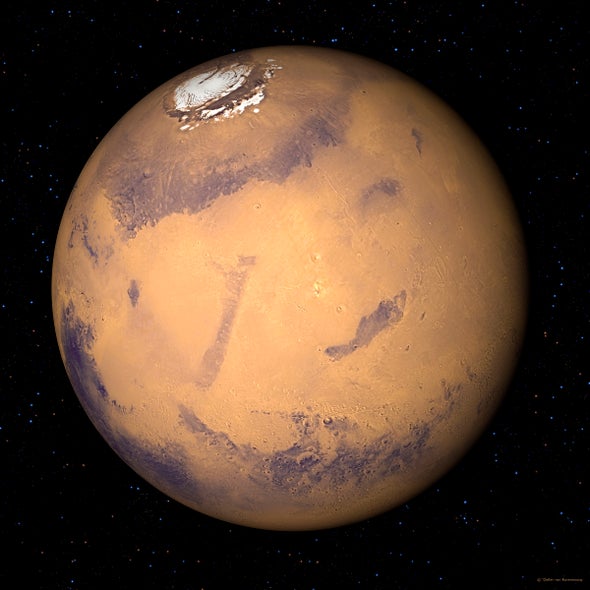(单词翻译:单击)
听力文本
This is Scientific American's 60-second Science, I'm Christopher Intagliata.
Just like here on Earth, we have earthquakes, the planet Mars has "Mars-quakes."
"Although the quakes we see on Mars are actually more similar to the kinds of things we see in the middle of plates on the earth, what we call inter plate earthquakes. And so something that might happen in Montana or South Carolina, for example."
Bruce Banerdt, a planetary geophysicist at the Jet Propulsion Lab in California. He explains that as the hot center of the planet cools, it slowly shrinks. "So the frozen outer layers, basically, after a while, they're too big for the rest of the globe, and they have to kind of crinkle to stay, you know, contiguous on a shrinking ball." And that crinkling causes quakes.
NASA's InSight mission, which landed on the Red Planet about a year ago, placed a seismometer on the planet's surface to listen for quakes. And it's captured signals from more than 100—some large enough that you'd feel them if you were standing nearby. Like this magnitude 3.7, recorded back in May.
(CLIP: Marsquake sound in)
Just to know, it's been sped up to be audible—and you really need headphones to hear the ferocious rumbling.
(CLIP: Marsquake sound out)

"We use these signals from Mars-quakes to probe the deep interior of Mars. They work almost like x-rays, you know. They pass through the planet; they bounce off boundaries, like between the crust and the mantle, the way an x-ray bounces off a bone. And we can actually, over time, put together a 3-D image of the inside of a planet, using seismology."
To accurately read those seismic sounds, though, the researchers have to filter out background noise—such as these "dinks and donks", as they call them:
(CLIP: Dinks and donks sample)
The scientists think those sounds might simply be the seismometer creaking as it expands and contracts with daily temperature swings.
InSight also has another tool, a heat probe, to directly measure the heat seeping out of that slowly cooling core. It's nicknamed "the Mole," because it's designed to burrow 16 feet below the Martian surface—although, right now, it's stuck at just 14 inches deep.
If the geophysicists can get the Mole to burrow better, it'll give scientists one more tool to understand the Red Planet's deep history—maybe even including how Mars and the Earth formed, 4.5 billion years ago—in what must have been a truly Richter-breaking shake-up.
Thanks for listening for Scientific American's 60-second Science. I'm Christopher Intagliata.
参考译文
这里是科学美国人——60秒科学系列,我是克里斯托弗·因塔格里塔。
和地球一样,我们有地震,火星上也有“火星地震”。
“尽管我们在火星上看到的地震实际上更类似于地球板块间的地震,我们称之为——板缘地震。比如蒙大拿州或南卡罗莱纳州可能发生的那种地震。”
加州喷气推进实验室的行星地球物理学家布鲁斯·巴纳特说到。他解释说,火星会随着其炎热中心的降温而慢慢缩小。“因此,一段时间之后,冰冻的外层对于火星其余部分来说会过于庞大,外层不得不皱起才能与不断缩小的球体保持相连。”这种皱起会引发地震。
一年前,美国国家航空航天局(NASA)的“洞察”号探测器在火星登陆,并在火星表面放置了地震仪来监测地震。其从100多个信号中捕捉地震信号,有些信号大到你站在附近都能感觉到。比如5月份记录下的这场3.7级地震。
(音频片段:火星地震的声音)
信号已加速到可以听到的程度——你真的需要戴上耳机听听这些凶猛的隆隆声。
(音频片段:火星地震的声音)
“我们利用这些火星地震信号来探测火星深处。信号的工作原理就像X光一样。信号穿过火星,遇到地壳和地幔之间的边界反弹,就像X光遇到骨头反弹一样。随着时间的推移,我们可以利用地震仪将火星内部的三维图像组合在一起。”
不过,为了精确解读这些地震声音,研究人员必须过滤掉背景噪音,比如这些“叮叮咚咚”的声音。
(音频片段:叮叮咚咚的声音样本)
科学家认为,这些声音可能只是地震仪因每日温度变化而伸展收缩时所发出的咯吱声。
“洞察”号还有一个工具——热探头,它可以直接测量从逐渐降温的核心渗出的热量。这个热探头的绰号是“鼹鼠”,因为其被设计为可钻入火星表面以下16英尺,尽管它现在只挖到14英寸深。
如果地球物理学家能让是“鼹鼠”挖得更好,那就能为科学家提供多一种工具来了解这颗红色星球的深层历史,甚至可能包括4.5亿年前火星和地球的形成方式——那一定是一场真正突破里氏震级的剧变。
谢谢大家收听科学美国人——60秒科学。我是克里斯托弗·因塔利亚塔。
译文为可可英语翻译,未经授权请勿转载!
重点讲解
重点讲解:
1. be similar to 相像的;相仿的;类似的;
The accident was similar to one that happened in 1973.
这次事故和1973年发生的那起事故很相似。
2. speed up 加快(…的)速度;
I kept praying that the DJ would speed the music up.
我不停地祈望唱片播放师能加快音乐的节奏。
3. put together 装配;组装;拼合;组合;
He took it apart brick by brick, and put it back together again.
他一块砖一块砖地把它拆开,然后又把它组合起来。
4. filter out 滤除;滤掉;
Children should have glasses which filter out UV rays.
儿童应该戴上滤除紫外线的眼镜。


